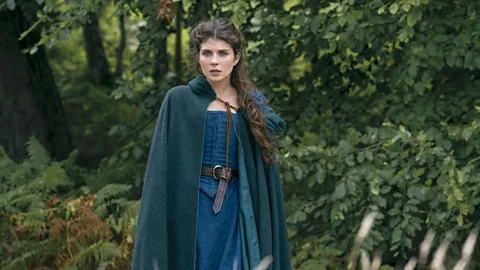 Amazon Prime Video
Amazon Prime Video
(Credit: Amazon Prime Video)
A short-lived teenage monarch in Tudor history has now inspired a fantastical TV romp on Prime Video. But ridiculous as it is, it highlights how the ill-fated Lady Jane Grey was much more than a victim.
Since her execution 470 years ago, Lady Jane Grey has lived on in the public imagination as the quintessential victim. Just 16 when she was pushed on to the English throne by her ambitious father-in-law, Jane reigned for only nine days. She was subsequently beheaded upon the order of vengeful Queen Mary, who took the throne from her and, as the story goes, could not tolerate a rival claimant for the crown remaining alive.
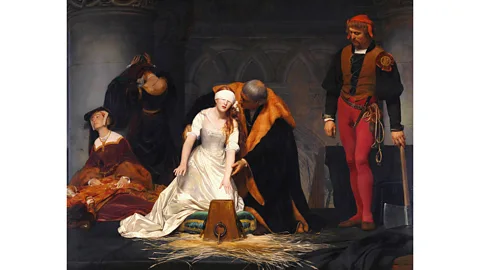 Alamy
Alamy
The Execution of Lady Jane Grey by Paul Delaroche, painted in 1833, depicts the execution of the teenage Tudor queen (Credit: Alamy)
Reinforcing this narrative is Paul Delaroche’s 1833 portrait of Jane, on permanent display at the National Gallery in London. Kneeling, blindfolded, clad in white, Jane gropes for the block, an innocent lamb readying herself for slaughter.
During her short life Lady Jane Grey was outspoken – which did much to seal her fate
In reality, Lady Jane Grey was a far more complex character. The grand-niece of Henry VIII, she was “a rather abrasive person”, suggests Dr Samantha Rogers, who teaches Tudor history at Nashville’s Vanderbilt University. “She was also dour and pious. I suspect I would not have wanted to be friends with her.”
Yet, during her short life Lady Jane Grey demonstrated plenty of agency, to use modern parlance. Queen Mary was initially willing to pardon Jane after she was tried and found guilty of treason, but Jane continued to be an outspoken Protestant – fiercely opposed to Mary’s reintroduction of the Catholic Mass in England – which did much to seal her fate.
On a page of the prayerbook she carried to the scaffold, now in the British Library’s collection, she penned a heartfelt message to her father, urging him not to mourn her and her husband Guildford Dudley’s execution: “Trust that we, by leaving this mortal life, have won an immortal life.”
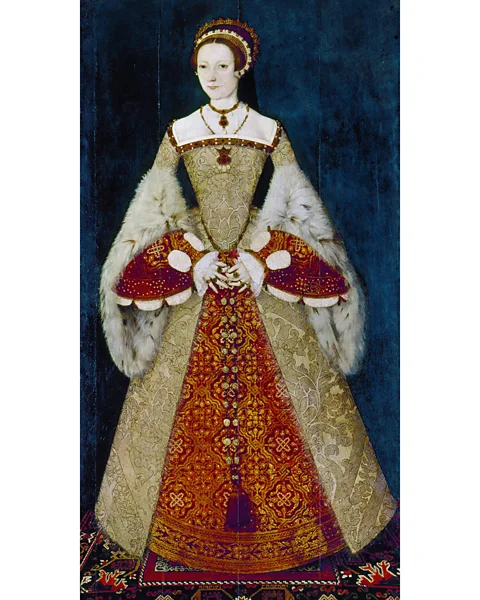 Alamy
Alamy
The real Lady Jane Grey of Tudor history, depicted here on a 1545 panel, was bravely outspoken about her beliefs (Credit: Alamy)
But neither this Lady Jane Grey – strong and fearless, willing to die for what she believed – nor the familiar passive victim, is the heroine of My Lady Jane. The eight-part mini-series, streaming from 27 June on Prime Video, imagines a Jane so different from the actual Jane as to be risible. She’s played by US actress Emily Bader as a feisty 21st-Century gal, plopped down in Tudor world: bawdy, irreverent, and dead-set on living it up and loving whoever she pleases. God never comes into it. This Jane also speaks like a Valley Girl and cavorts with friends who have the magical ability to shapeshift into animals.
Confused yet?
In truth, My Lady Jane owes little to the past and most everything to the red-hot centre of now. Romantasy – a portmanteau of romance and fantasy – is the fastest growing genre of contemporary fiction among young female readers. TV producers formerly fashioned mini-series out of meticulously researched historical fiction; Hilary Mantel’s Wolf Hall comes to mind. But Netflix’s Bridgerton, based on the novels of Julie Quinn, tapped into the popularity of love stories set in an alternative past. In this hugely successful show, George III’s bi-racial wife Queen Charlotte – there is a debate among historians about her real-life African descent – presides over a Regency society where racial equality is well established. Viewers can relish the venerable thrill of the Austen-ite romantic chase (along with over-the-top costumes, not always period correct) with all troubling aspects of the era erased.
To be fair, My Lady Jane is so broadly comedic that the creators’ indifference to the facts is never in doubt
One imagines that Mantel, who died in 2022, would be singularly unimpressed by both Bridgerton and My Lady Jane, adapted from a best-selling Young Adult novel by Brodi Ashton, Cynthia Hand and Jodi Meadows. In her 2017 Reith lecture for the BBC, Mantel declared: “This is a persistent difficulty for women writers, [they] want to write about women in the past, but can’t resist retrospectively empowering them. Which is false.”
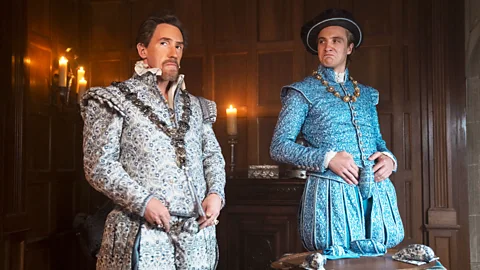 Amazon Prime Video
Amazon Prime Video
My Lady Jane is a comedic historical-fantasy series set in an alternative past universe (Credit: Amazon Prime Video)
To be fair, My Lady Jane is so broadly comedic that the creators’ indifference to the facts is never in doubt. And historian Nicola Tallis, who published an acclaimed biography of Jane, Crown of Blood, in 2016, forgives them this. “We must remember that there is a lot we don’t know about Jane,” Tallis tells the BBC. “Which in turn offers a relative degree of freedom when shaping a TV narrative. What we do know is that she was incredibly strong minded, and I think it’s quite refreshing to see her presented in a way that seeks to highlight this. We should be celebrating her as a young woman who wasn’t afraid to make her voice heard in a man’s world.”
The rise of romantasy
Tallis is echoing a broader point about the appeal of romantasy content. Asked to explain the phenomenon, the president of the International Association for the Study of Popular Romance, Professor Jayasheee Kamblé, tells the BBC: “This kind of reimagining is a way to snatch female agency from the death and silencing that dominates so much of the past when it comes to women. That’s pleasurable in itself. It’s also a kind of fan fiction that creates powerful reframings of marginalised identities, and makes new lives seem achievable for the present generation of marginalised folks – who may know the existing history.”
TV Jane has no difficulty defying authority. When Dudley, a man she has never met, is floated as a potential husband, she dismisses the whole idea of marriage saying, “I want my life to be mine, forever”. It’s only when she accidently encounters the man, played by Edward Bluemel, in a tavern, and discovers he is very attractive (another, less polite, term is used) that she will consider the match.
Completely absent from My Lady Jane is any mention of the questions of faith so central to Lady Jane Grey’s life. The English Reformation, which began with Henry VIII’s decision to break with Rome to divorce his wife, caused civil strife for decades – the clash between Catholic Queen Mary and Protestant Lady Jane being only a single chapter. But the scriptwriters, by contriving animosity between the Ethians (those magical people who can change themselves into animals) and the Verities (everyone else), gesture at the violent religious conflict of the 1500s.
This may be the silliest part of a very silly show – although the visual effects are impressive. Mantel, in her Reith lectures, acknowledged how difficult it is for those of us alive today to appreciate the religiosity of our ancestors. For them, she said, “this life was short and hard. Its aim was salvation. The single aim of salvation permeated their thinking and governed their actions day by day.”
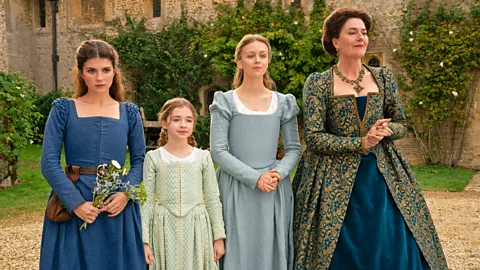 Amazon Prime Video
Amazon Prime Video
Emily Bader (left) stars in the series, a fun romantasy that clearly makes little claim to historical accuracy (Credit: Amazon Prime Video)
Despite all that is added in and left out – as well as distorted, derided and devalued – about the life of its noble subject, Dr Rogers says she plans to tune into My Lady Jane. “It may be that I watch it with a fellow historian while we giggle and enjoy a glass of wine.” Dr Tallis hopes the series will encourage renewed interest in the teenage martyr. “My feeling is that if alternative history engages people enough that it encourages them to go away and find out the true story then it’s a good thing. If it’s accepted as fact, it becomes problematic.”
There seems to be little danger of the second. Even the most un-Tudor-ed among us will recognise My Lady Jane as a frothy bit of fun – and sing along perhaps, as heavily costumed riders tear through the leafy forests of England on horseback, to a soundtrack of Wild Thing and Rebel, Rebel. If this sounds appealing, go ahead and saddle up.
Clare McHugh is the author of The Romanov Brides, published by Harper Collins. My Lady Jane is streaming from 27 June on Prime Video.


